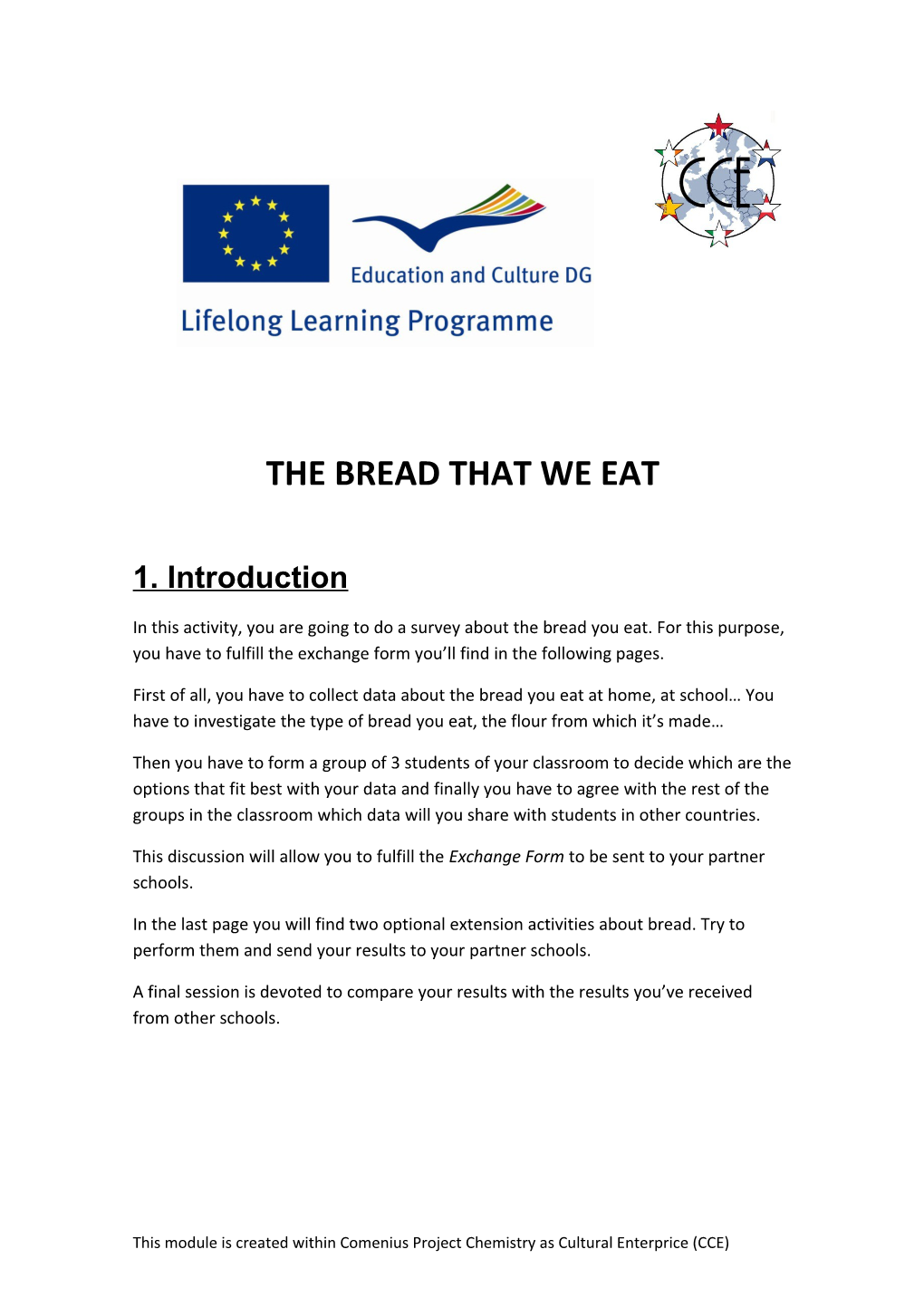THE BREAD THAT WE EAT
1. Introduction
In this activity, you are going to do a survey about the bread you eat. For this purpose, you have to fulfill the exchange form you’ll find in the following pages.
First of all, you have to collect data about the bread you eat at home, at school… You have to investigate the type of bread you eat, the flour from which it’s made…
Then you have to form a group of 3 students of your classroom to decide which are the options that fit best with your data and finally you have to agree with the rest of the groups in the classroom which data will you share with students in other countries.
This discussion will allow you to fulfill the Exchange Form to be sent to your partner schools.
In the last page you will find two optional extension activities about bread. Try to perform them and send your results to your partner schools.
A final session is devoted to compare your results with the results you’ve received from other schools.
2. Exchange Form
TO:
DateTeacher’s name
School
Address
Phone numbers
(inc. dialling code) / Telephone:
Fax:
E-mail address
School website address
We understand that your class is studying Bread. We would like to exchange information and the results of our own experiments and research.
We look forward to hearing from your class. Please reply.
FROM:
Teacher’s nameSchool
Address
Phone numbers
(inc. dialling code) / Telephone:
Fax:
E-mail address
School website address
3. Information and activity sheets
SURVEY ABOUT BREAD IN OUR COUNTRY
1.- Which is the main source of starch in your country:
a)Wheat (including flour, bread, biscuits, etc.)
b)Corn (including flour, tortitas, etc.)
c)Rye (including flour, bread, biscuits, etc.)
d)Oats (including flour, bread, biscuits, etc.)
e)Rice
f)Other (specify):______
2.- Which type of bread do you eat usually?
a)Crusty
b)Non-crusty
3.- Which is the most common flour used in your country to produce bread?
a)Refined flour (white)
b)Whole flour (integral or brown)
4.- When do you usually eat bread?
a)Breakfast
b)Lunch
c)Tea time
d)Dinner
5.- How do you usually eat bread?
a)With the main meals (lunch, dinner, etc.) accompanying other foods
b)As a sandwich
6.- Bring a label from a flour packet, scan it or copy its ingredients (with percentages) and send it to your partner schools.
7.- Ask at home if they ever use yeast (i.e. for cooking cakes or biscuits). If yes, investigate which type they use:
a)Biological
b)Chemical
c)They use it but don’t know the type
d)None
8.- Go to your local bakery and ask them which is the most popular (sold) type of bread (you could include some pictures to illustrate the different breads sold in your bakery).
9.- Investigate at home if the type of bread you eat nowadays is the same as when your parents were children or if there has been any change in it.
10.- Try to find information about which kind of organism is yeast. Investigate if it’s used by humans for purposes other than obtaining bread.
BREAD IN OUR COUNTRY – EXCHANGE FORM
1.- the main source of starch in your country is:______
2.- At home/school the type of bread we usually est is (crusty/non crusty):______
3.- The most common flour used in our country to produce bread is:______
4.- The meals in which we usually eat bread are:______
5.- The way we usually eat bread is:______
6.- We have studied the label of a local flour. The main ingredients and their percentages are:
a)______
b)______
c)______
d)______
7.- At home we usually (use/don’t use) yeast. The most common type of yeast in our country is:______
8.- We made a survey in our local bakery to investigate which types of bread are most popular (sold). These more common types include ( please attach some pictures and description of the breads):
9.- Asking our parents we have found that we eat (more/less) bread than before and that the types of bread we eat normally (have/have not) changed (If yes, describe please).
10.- These are the results of our research about yeast:
EXTENSION ACTIVITY # 1: Yeast action
- Put in a test tube a certain amount of flour and water. Add some yeast and see what happens.
- You can measure the amount of gas (which gas?) released by closing the test tube with a cork and inserting an empty syringe in it.
- Even better, if you have a data logger and a pressure sensor you can measure the “amount” of gas released more accurately.
- Try these experiments with different types of yeast but keep the amount of flour, water and yeast the same (temperature should also be the same!).
- Send your results together with your exchange form to your partner schools.
EXTENSION ACTIVITY # 2: Acidity of flours
- Mix a certain fixed amount of flour with a fixed amount of water (keep them always the same!) for different types of flour.
- Stir well until you get an homogeneous mix
- Introduce in the mix a strip of paper filter and find its pH or, if you have a pH-meter, use it to measure the pH.
- Try to find some relationship between acidity (pH) and any of the ingredients of the flour (you have to compare your pH results with the different flour labels).
- Send your findings to your partner schools.
4.Teacher notes
Most of the activities speak for themselve and are easy to extend. Look also to our public website:
This module is created within Comenius Project Chemistry as Cultural Enterprice (CCE)
